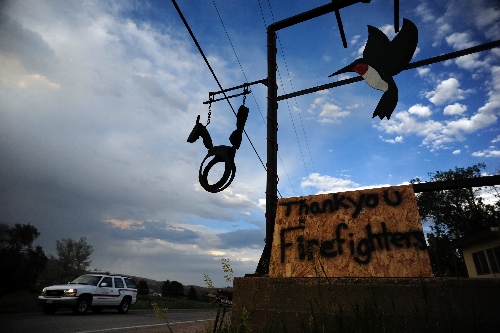Aviation contracts awarded for firefighting air tankers
WASHINGTON - In what was fast becoming a grim rite of summer, wildfires sprang up at hot spots nationwide, and some of the government's over-the-hill air tankers went down fighting them.
Nearly two weeks after the latest fatal crash of an old air tanker in Utah, the U.S. Forest Service announced Wednesday that four contracts have been awarded to aviation companies to upgrade its fleet of large firefighting airplanes, many of which date to the Eisenhower administration.
The announcement came on the same day that President Barack Obama signed a bill to speed up the Forest Service's contracting process. The agency does not own large air tankers; it enters into agreements with aviation companies that buy used aircraft, redesign them for firefighting and make them available for government use.
Agency chief Tom Tidwell called the contracts "a major milestone in our efforts to modernize the large-air-tanker fleet," which plays a vital role in fighting wildfires. But critics said the agency, an arm of the U.S. Department of Agriculture, waited too long to acquire funds from Congress to update the fleet as planes crashed and crew members died.
Two crew members died June 3 when their 57-year-old Lockheed P2-V flew into the side of a mountain in Utah, west of Cedar City near the Nevada state line.
Todd Neal Tompkins and Ronnie Edwin Chambless, pilot and co-pilot, both of Boise, Idaho, were killed.
That same day, a 55-year-old P2-V battling a blaze in California was forced to make a wheels-up landing while attempting to pick up fire retardant. No injuries were reported.
"As we mourn the recent loss of two air tanker pilots, we must continue to meet our responsibility to be prepared to respond vigorously to wildfires threatening lives, communities and cultural and natural resources," Tidwell said in a statement.
The nation's contracted fleet of large air tankers fell from 44 in 2002 to nine last year after a long list of problems forced the grounding of aircraft and the canceling of contracts. The Forest Service also leases smaller planes and helicopters to control big fires, but large tankers are coveted because they can lay down three times more flame suppressant.
There have been at least five deadly crashes of ancient air tankers since 2002, killing 13 people, according to the Associated Aerial Firefighters. In two 2002 incidents, the wings broke off a 1956 C-130 Hercules over California and a 1945 PB4Y-2 Privateer over Colorado.
The four companies awarded contracts - Neptune Aviation Services of Missoula, Mont.; Minden Air of Minden; Aero Air of Hillsboro, Ore.; and Aero Flite of Kingman, Ariz. - can choose from a variety of planes.
Under the new contract, the next generation tanker must be turbine-powered, capable of carrying more than 3,000 gallons of retardant and cruise at no less than 300 knots when fully loaded, said Jennifer Jones, a Forest Service spokeswoman.
The government will pay two fees for next-generation air tankers: a daily rate that guarantees that planes are available, paid whether they are flying or not, and an hourly rate when they are fighting fires. The Forest Service will pay an average daily rate of about $26,000 and an average hourly flight rate of about $8,600 this year and next, Jones said, up from about $10,000 and $5,750 currently paid for older P2-Vs.
Nine older air tankers are currently available. Neptune and Minden have about two months to put three next-generation air tankers into service. Aero Air, Aero Flite and Minden are obligated to put four more tankers into service next spring.
The new contracts and standards are "definitely a step in the right direction," said Dennis Hulbert, a retired regional aviation officer for the Forest Service.
But there are concerns because "they're going to a total jet fleet" and "to a degree, there's still a lot of unknowns about flying jets. We don't know if they'll meet the drop patterns or the performance issues," he said.
Tony Morris, founder of the Wildfire Research Network, agreed that the contracts are a step forward, but "we should have had these 'updated' planes available to us ... two or three years back." It's an incremental step substituting for what is needed: a visionary plan, he said.
Wildfires scorch millions of acres every year. At least 10 states have suffered record fires since 2000, and with "the changing climate, fire seasons will likely become longer and more severe," Forest Service officials said, making a case for newer planes in a recent 12-page strategy paper.
WEST ablaze
Fires burning across the West include the following:
• Arizona: A 480-acre wildfire near the Grand Canyon was 70 percent contained. A 2,860-acre fire and a 200-acre fire near Superior east of Phoenix were 50 percent contained.
• Colorado: The 78-square-mile High Park Fire west of Fort Collins was 10 percent contained. Gov. John Hickenlooper banned open burning and private use of fireworks. Authorities determined that six small wildfires near the Breckenridge Nordic Ski Center were intentionally set.
• New Mexico: The Little Bear Fire, which has scorched 58 square miles and destroyed at least 224 homes in the Sierra Blanca range near Ruidoso, has been 40 percent contained, but firefighting officials expressed concern about continued dry and sunny conditions.
• Washington: A wildfire burned about 1,500 acres of sagebrush and grass between Othello and Royal City in south-central Washington.
THE ASSOCIATED PRESS


















